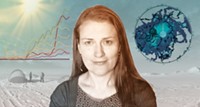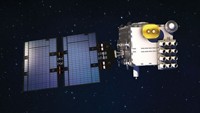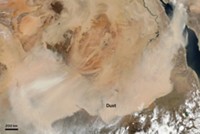Advertisement
Grab your lab coat. Let's get started
Welcome!
Welcome!
Create an account below to get 6 C&EN articles per month, receive newsletters and more - all free.
It seems this is your first time logging in online. Please enter the following information to continue.
As an ACS member you automatically get access to this site. All we need is few more details to create your reading experience.
Not you? Sign in with a different account.
Not you? Sign in with a different account.
ERROR 1
ERROR 1
ERROR 2
ERROR 2
ERROR 2
ERROR 2
ERROR 2
Password and Confirm password must match.
If you have an ACS member number, please enter it here so we can link this account to your membership. (optional)
ERROR 2
ACS values your privacy. By submitting your information, you are gaining access to C&EN and subscribing to our weekly newsletter. We use the information you provide to make your reading experience better, and we will never sell your data to third party members.
Climate Change
Covid-19
COVID-19 has disrupted fieldwork. Here’s how environmental chemists are coping
The pandemic has delayed environmental monitoring, but some scientists are finding ways to pivot
by Katherine Bourzac
June 29, 2020
| A version of this story appeared in
Volume 98, Issue 25

Spring and summer are when many environmental scientists normally head into the field to collect data. That’s when it’s safe to summit a glacier high in the mountains to retrieve ice cores. It’s when nutrient runoff and weather patterns combine to trigger the toxic algal blooms that researchers track. And it’s when the rice that scientists monitor for arsenic ripens.
But this year is different. Around the globe, the COVID-19 pandemic has claimed countless lives, caused economic upheaval, and, for scientists who monitor our environment, thrown research programs into a tailspin. Travel restrictions and other safety measures shut down programs, delayed trips, and triggered anxiety among students counting on the data from this season to finish their degrees or ensure their funding. And the more time researchers are away from their projects, the more significant the gaps will be in their data. Long-term, continuous environmental monitoring allows water quality scientists to catch problems earlier, when they’re easier to address; provides compelling and rich evidence for arguments about nuances in climate science; and helps researchers maintain momentum on projects in remote areas that are logistically challenging to restart.
Amid the disruption, environmental chemists are searching for ways to limit the damage to long-term projects, and some are even finding new experimental opportunities and ways of working. Here’s a look at how four groups of scientists are dealing with the challenges.
Alison Criscitiello
Arctic expedition deferred

In 2017, a freezer at the Canadian Ice Core Lab (CICL) failed, melting 180 ice cores. These cylindrical samples, collected painstakingly from the Canadian Arctic in prior years, represented a unique record of climate history from the region. Among the samples was some of the oldest ice taken from Mount Logan, Canada’s highest peak, located in Yukon.
Eager to replace what was lost, Alison Criscitiello had been planning an expedition to Mount Logan, which was to take place in two stages over two years, starting in spring 2020. Criscitiello, the director of the CICL, had been training for the trip for seven months, spending time in an altitude-simulation chamber to get in good condition. Mount Logan sits at an elevation of 5,959 m, and she and her team needed to physically prepare to endure the grueling conditions there.
Ice cores, taken from ice sheets and glaciers, contain hundreds of thousands of years’ worth of accumulated snow. Their layers—formed when snow containing a sample of what was in the atmosphere is compressed into ice—can tell climatologists about Earth’s historical temperature record, levels of carbon dioxide and other atmospheric gases, and annual concentrations of pollutants such as lead. But they’re not easy to acquire: drilling and collecting them requires complex scientific expeditions that take years to plan.
Criscitiello’s trip to Mount Logan is now postponed.
Getting an ice core isn’t just a matter of hauling equipment up the world’s tallest mountains and starting to drill—it’s far more deliberate than that. To make sure they would be drilling in the best possible place on Mount Logan, Criscitiello and her team had planned to spend their spring trip mapping the ice formation by dragging a radar system across it. The idea was to drill where the annual layers of ice are as parallel to each other as possible, so that the annual record is clear. Mapping the ice formation would also enable the researchers to drill as deep as possible, thereby going as far back in time as possible.
Due to the pandemic, the spring mapping trip has now been scrapped, and the team will have to make its best guess about where to drill when the expedition resumes in 2021. “The science takes a real hit,” Criscitiello says. But she didn’t want to push the entire project to next year and still do it in two stages because that would mean grad students and postdoctoral scholars who are planning to study the ice would be delayed a year in their work and careers.
Many glaciologists are in similar situations. This month, the US and the UK announced the cancellation of all Antarctic field research for the 2020 season. These cancellations mean disruptions in the collection of data that are used to model our rapidly changing climate. And some places—like the Canadian Arctic—are warming rapidly, which means the record in the ice is at risk of being damaged.
Like many scientists with canceled plans in 2020, Criscitiello says the scientists on her team are “really disappointed, but trying to keep perspective.”
Tony Hale And Donald Yee
Delays in water quality monitoring

Algae in rivers and in the ocean thrive on nitrogen and other nutrients that run off from farms and sewage. But when algae bloom, other organisms in the ecosystem can suffer: high levels of phytoplankton can suck up oxygen, choking out other creatures, and can produce toxins harmful to sea lions, people, and other animals.
Phytoplankton blooms in the San Francisco Bay usually start in March. So the San Francisco Estuary Institute (SFEI) starts its research cruises at the same time. SFEI partners with regional and national government agencies, including local water boards, as well as businesses and nongovernmental organizations, to keep an eye on the region’s water quality. The institute monitors nutrient concentrations and provides regional governments with the information they need to address the blooms, by implementing changes to wastewater treatment, for instance.
But the Bay Area’s shelter-in-place order went into effect at midnight on March 17, forcing the institute to halt all research cruises, says Tony Hale, director of the environmental informatics program at SFEI.
Nutrient monitoring is just one activity at SFEI. Institute scientists monitor water quality and ecosystem health in the San Francisco Bay and the large river delta and estuary whose waters flow into it. The pandemic has disrupted this work.
The shelter-in-place order has also delayed the institute’s work monitoring contaminants in fish. Last year, the Regional Monitoring Program for Water Quality in the San Francisco Bay collected sport fish samples from around the region, but SFEI scientists haven’t been able to test them because their labs have been closed. That means Bay Area fishers have yet to receive warnings about what fish might be unsafe to consume this season.
But Hale says things are changing quickly as California reopens. As its scientists go back to work, the institute is working on safety protocols to strike what Hale calls the “delicate balance” between monitoring water quality and keeping researchers safe. SFEI staff got into the field for the first time in mid-June.
Moving forward, Donald Yee, senior environmental scientist with the institute’s clean water program, expects that some work the institute normally does—including joining collaborators during sampling trips to ensure SFEI project scientists understand the context for the data being submitted by those collaborators—will, for the time being, have to be done over video calls. However, he notes that the institute’s researchers already wear some personal protective equipment as a matter of course, which will provide a good basis for getting back into the field safely. Once they get back out in the field, Yee says, researchers will have to add additional protective gear, like masks, to protect themselves from each other.
Joellen Russell
An unexpected global experiment

For some atmospheric chemists, the COVID-19 pandemic has presented an unanticipated research opportunity—though not one anyone would have asked for. Thanks to movement restrictions and slowed economic activity, anthropogenic emissions of greenhouse gases and other pollutants have sharply decreased. For example, carbon dioxide levels fell by as much as 17% worldwide by late April.
“Less burning of fossil fuels means less aerosols in the air,” says Joellen Russell, a biogeochemist and chair of integrative science at the University of Arizona. Most aerosols reflect the sun’s light, so they tend to have a slight cooling effect on Earth’s climate. The unusually low emissions seen this spring present an opportunity for climatologists and atmospheric chemists to test their atmospheric models. Will the low levels of aerosols have the expected regional temperature effects, or not? Scientists will be able to use the answer to fine-tune their climate models.
And, Russell notes, they can ask that question from their desks. Satellites and ground-level sensors stream data about the chemical composition of the atmosphere to computer banks, and scientists run their models on remote supercomputers—business as usual. Russell notes that the US Department of Energy, for example, has kept these powerful computing systems online during the pandemic. She says work happening right now also is likely to lead to fine-tuning of weather models—and better predictions for the future.
Russell says there’s an increasing effort to push these models to be more predictive. “We don’t just need the weather report, we need to know the likelihood of impacts” like wildfires, she says.
Russell has also been fortunate that she could continue with her work on carbon cycling in the Southern Ocean during the pandemic. Since this research relies on already-positioned robotic floats loaded with sensors that beam data to satellites, “we’re able to go pretty cleanly virtual,” she says. The satellites send the data to supercomputers, which Russell’s team can access remotely.
Still, Russell has not completely escaped fieldwork disruptions. She had planned to travel to New Zealand in March; she hopes to go next February to begin a collaboration with the country’s National Institute of Water and Atmospheric Research.
Between the pandemic and climate change, Russell says, “this is really hard on so many people, but it’s also an incredible time to be an earth scientist.”
Benjamin Bostick and Alexander Van Geen
Finding new ways of working remotely

When reached by phone in mid-June, Benjamin Bostick, a geochemist at the Columbia University Lamont-Doherty Earth Observatory, was unwrapping a snack for his daughter on her fifth birthday. “I’m in a small New York apartment,” he said. “We don’t have an office—we don’t even have a desk.”
Bostick usually works out of his Columbia office and lab and frequently travels abroad for fieldwork. This summer, he was supposed to be working with rice farmers in Vietnam and Cambodia to study the distribution of arsenic in their water supply and how the toxic metalloid is taken up by the rice. Bostick was in those two countries setting up experiments in January; due to travel restrictions, he’s had to temporarily drop the project. “Being frozen in time” is particularly disruptive for “experiments that have time components, like growing rice,” he says.
He’s worried about funding for his graduate students and the future of the project. Funders are being understanding so far, he says, but it’s not yet clear whether they will want to keep funding students who can’t work on their research projects because they don’t have samples. A week or two of fieldwork can feed into a year or two of analysis back in the lab. Environmental chemists—particularly those who are currently students—will be feeling the effects of this year’s cancellations for some time.
Alexander van Geen, a geochemistry colleague of Bostick’s who also monitors arsenic, has been working with people in Bangladesh to monitor the metalloid in their water. A third of the wells in Bangladesh do not meet the World Health Organization’s standards for arsenic in drinking water. But it’s complicated to keep tabs on the problem because arsenic levels are extremely variable well to well, and people dig new wells all the time. So iterative, on-the-ground measurements are key.
Van Geen’s group has trained people in Bangladesh to use colorimetric tests to assess levels of arsenic in their water, and the researchers have developed a smartphone app that can be used to report the results and share them with neighbors.
Advertisement
Thanks to their history of working on the well-monitoring project, when the COVID-19 pandemic struck, van Geen and his group had already amassed a large database of phone numbers for people in Bangladesh. He decided to put that bank of phone numbers to good use. Van Geen and his team secured a US National Science Foundation rapid grant, which they used to reach 60,000 households in Bangladesh. They collected data about how many people living in each home died this spring, as well as last year. Van Geen says this information will help determine excess mortality attributable to COVID-19 and help track the spread of the disease.
In time, van Geen expects data from these two projects will make it possible to look for a link between arsenic exposure and COVID-19 infection rates and mortality. Arsenic exposure is associated with many health problems, including some related to the immune system.
Bostick says the current circumstances present an opportunity for environmental chemists who do work in other countries to rethink how they go about it. “We can encourage more active participation by the people in the countries where we work,” he says. This strategy will have to be applied in the future, though, because Bostick can’t currently travel to his study sites to teach and equip local collaborators.
For those lucky enough to remain healthy, the pause in usual patterns of scientific work provides an opportunity for reflection. “Field research is incredibly personalized and individual,” Bostick says. He’s taking the time to pore over data he gathered before the pandemic, looking for new angles that might broaden his research.





Join the conversation
Contact the reporter
Submit a Letter to the Editor for publication
Engage with us on Twitter